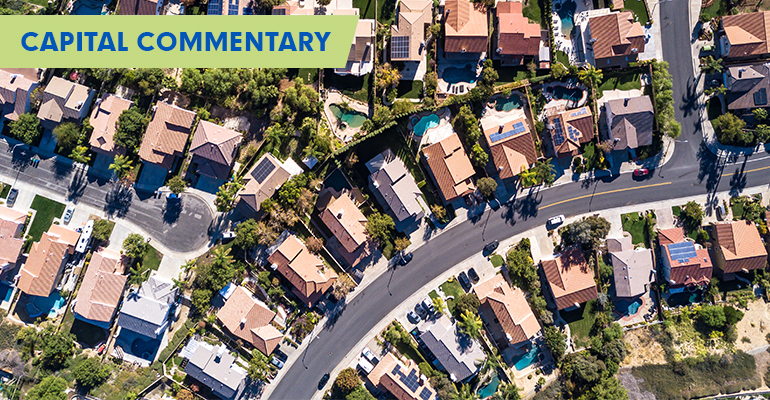
The nation’s housing affordability crisis isn’t spread evenly across our 50 states. Ironically, states that are proud of their reputation as the most progressive and politically attuned to the problem of affordability are having the greatest difficulty solving it.
Call it the Blue State Housing Blues.
This edition of Arch MI’s Capital Commentary delves into the paradox and reports on resulting population shifts that mean one state, in particular, is prospering.
1. “Here’s Looking at Blue, Kid”
It didn’t get past the liberally inclined New York Times to point out that you’d be better off looking at red, not blue, states when it comes to finding affordable housing.
“Blue States, You’re the Problem,” an opinion-section video produced by Johnny Harris and Binyamin Appelbaum, put the blame squarely on Democrat-controlled states such as California, New York and Illinois for failing to live up to their values.
The producers singled out California’s failure to solve its affordable housing crisis.
“You know where those signs are? When you drive into a state it says, ‘Welcome to California.’ They might as well replace them with a sign that says, ‘keep out’ because, in California, the cost of housing is so high that for many people, it’s simply unaffordable,” said Appelbaum.
Harris pointed his finger directly at state residents who consider themselves progressive. “All around California, there are cities full of people who say they are progressives. They’re liberals. They believe in a more equal America … they put in lawn signs about everyone being equal, but at the same time, they’re actively fighting to keep their [single-family-only] neighborhoods.”
Appelbaum suggests these progressives are hypocrites. “I think people aren’t living their values. You go to these meetings in these neighborhoods where they’re talking about a new housing project and it’s always the same song and it goes like this: ‘I am very in favor of affordable housing. We need more of it in this community. However, I have some concerns about this project.’ And then off we go with the concerns, and nothing ever gets built.”
Appelbaum doesn’t limit his criticism to Californians. More recently, he authored an opinion article hammering Long Island, New York, for its prevalence of single-family-only neighborhoods.
“Of the 100 most populous counties in the United States, many of which are suburban, only one, Fort Bend County, Texas, outside Houston, has a larger share of single-family housing. Suffolk and Nassau (on Long Island) rank second and third,” he wrote.
But Appelbaum also sees signs of hope for more housing emerging from unexpected places, such as businesses struggling to fill jobs and families who want their children to live nearby.
“I’m not a bleeding-heart kind of guy, but this is a real need,” one export-import business owner told Appelbaum. He became a proponent for more homes when he couldn’t find enough workers for his company.
2. Blue Cities Aren’t Adding Homes, Either
Lack of affordable housing isn’t limited to communities in California, New York and Illinois, of course. Certain cities within more conservative states haven’t bothered to address housing needs either.
Politics North Carolina’s Alexander H. Jones took a swipe at Chapel Hill — home to the state’s flagship university — in “Housing Policy is Liberalism’s Achilles Heel.” He noted that:
- Between 2010 and 2020, the Raleigh-Cary metropolitan area grew by 23%, the second-fastest growth rate in the country.
- Neighboring Chapel Hill did not grow at all.

“The reason for this failure was housing policy,” wrote Jones. Home prices have soared, shutting out many former city residents such as artists, grad students and University of North Carolina faculty members, “replaced one for one by wealthy people in a trade-off that left the town’s population stagnant.”
If students, let alone the poor,” contends Harris, “cannot afford to live in a town that styles itself the capital of blue North Carolina, there are legitimate questions about whether the town’s liberalism is truly operative.”
3. Blame It On … Capitalism?
Perhaps liberals and conservatives are more alike than they prefer to admit — at least when it comes to housing policy.
That’s one conclusion Michael Manville, associate professor of urban planning at UCLA, reaches in a San Francisco Chronicle op-ed article (subscription required).
“Liberal people are often conservative when it comes to housing,” Manville writes. Many liberals own homes, and an old idea in political science suggests that homeownership bends local politics to the right. The reason for this influence is simple. Homeowners, though they probably don’t see themselves as such, are capitalists.”
And with so much personal capital wrapped up in home equity, Manville argues, homeownership can put liberals in a tough position.
“For homeowners, new development is competition. And no capitalist likes competition. It’s a threat to a vulnerable stock of wealth.”
In researching public opinion data, Manville found that homeowners, “even liberal ones, were more likely to oppose housing of every kind. Tellingly, owning a home did not influence attitudes about national policies, like gun control or health care; it only shifted opinions about housing.”
The professor’s research is borne out by the fact that more than 200 communities in California have sought ways to get around a new state law that allows up to four units on any single-family lot. Capital Commentary covered that topic in its February issue, NIMBYs: Hear Them Roar.
Manville also found a second major reason liberals might oppose more housing:
“Denser development requires deregulation — relaxing zoning and other rules — and deregulation is an ideologically charged concept often associated with conservatism. So even if development creates liberal outcomes (more affordability and less segregation), it might do so through what looks like an illiberal process.”
4. Texas Wants You.

Singer-songwriter Lyle Lovett could have represented the state’s Economic Development Corporation when he crooned: “That’s right, you’re not from Texas, but Texas wants you anyway.” The ongoing mad dash to Texas proves people are listening.
- Nearly 700,000 Californians moved to Texas between 2010 and 2020.
- Texas’s population increased by 4 million since the 2010 census, an enormous 15.9% jump. (The growth rate was exceeded by only the much-smaller states of Utah and Idaho.)
In the words of the New York Times, “Everyone’s Moving to Texas.” Here are some of the reasons:
- Jobs.
- Lower climate risks.
- Racial diversity.
- Affordability.
Those are the top considerations for people planning to relocate, according to the New York Times’ Farhad Manjoo, an opinion columnist based in California.
“Once I had put in all my priorities, I was left with a list of cities and towns near Dallas that checked all my boxes. I was starting to see why so many people are moving to Texas.”
Freakonomics Radio explored the topic, too, in its two-part podcast, “Why is Everyone Moving to Dallas?” It teased the broadcast this way:
- “When (host) Stephen Dubner learned that Dallas-Fort Worth will soon overtake Chicago as the third-biggest metro area in the U.S., he got on a plane to find out why … [H]e came away impressed.”
- Why the unusual two-part podcast? Because everything is bigger in Texas, quipped Dubner.
The Dallas Morning News reported that more than 16,000 Californians moved to North Texas in 2020, up 19% over 2019 relocations.
The increase was even higher for New Yorkers moving to the Metroplex, up more than 22%.
Eric Willett, director of research at CBRE, a global commercial real estate firm, said the region’s population growth “has been supercharged” by COVID-19.
Young, talented professionals represent the largest share of the influx.
Dallas’ surging popularity, of course, is being reflected in home prices. TV station KERA reported Dallas-Ft. Worth saw the fastest growth in home prices in history in 2021, with a typical home gaining $69,000 in equity, or 25%.
5. Contest #23: Pack Up the Van, I’m Movin’
A new national survey asked a couple of thousand college students about their most-desired post-graduation places to live if they leave their hometowns.
- You must answer two multiple-choice questions for this edition of the Capital Commentary Contest:
- Which city is the favorite destination for new grads?
- Nashville.
- Denver.
- Seattle.
- Dallas.
- What city is the top choice of Republicans who plan to leave home?
- Atlanta.
- Austin.
- Nashville.
- Washington, DC.
Email your answers to [email protected] by 12 p.m. ET, Monday, April 4 to be entered into the drawing for the Capital Commentary/PolicyCast mug and saucer.


About Arch MI’s Capital Commentary
Capital Commentary newsletter reports on the public policy issues shaping the housing industry’s future. Each issue presents insights from a team led by Kirk Willison.
About Arch MI’s PolicyCast
PolicyCast — a video podcast series hosted by Kirk Willison — enables mortgage professionals to keep on top of the issues shaping the future of housing and the new policy initiatives under consideration in Washington, D.C., the state capitals and the financial markets.
Stay Updated
Sign up to receive notifications of new Arch MI PolicyCast videos and Capital Commentary newsletters.